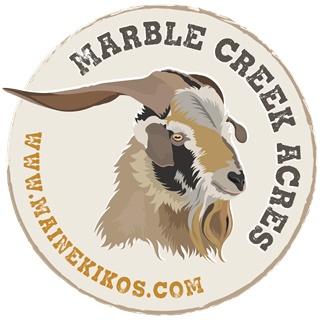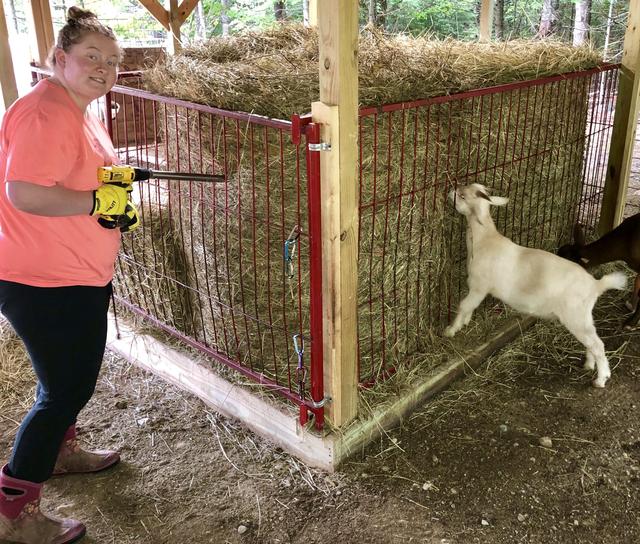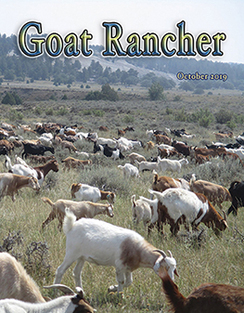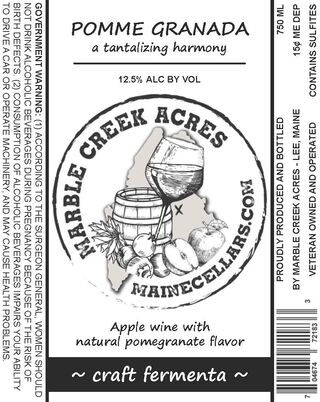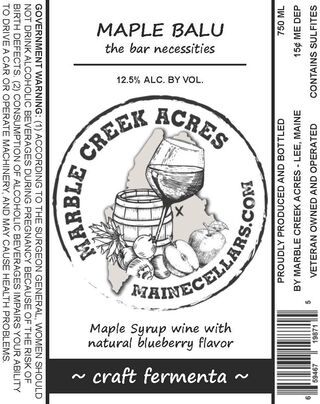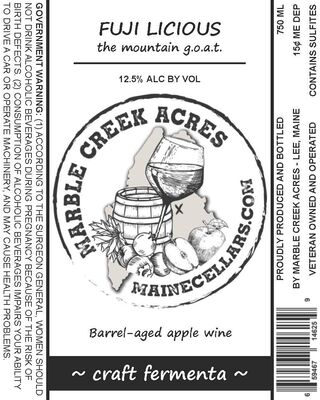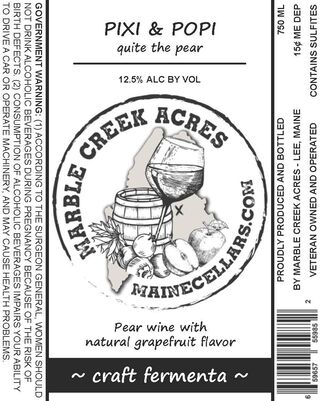Feed & Forage --- Winter is already knocking on our back door
Tuesday, October 1, 2019
As Fall approaches (still August at this point when sitting down to write this … type this?), feed and forage are top of our mind. With Winter around the corner --- Yes already! --- and it definitely seems to be arriving earlier and earlier here in Northern Maine, or at least Fall has arrived much earlier than normal, we are left wrestling with prepping our small rural homestead and goat operation for Winter. This includes considering how we will feed hay out over the cold months and what sub-groups we will feed; hay-only, grain (herd sires, bucklings, doelings, does, lactating does, late pregnancy does, etc.), likely some combination of both to meet the nutritional needs of our goats, especially with the lack of available forage to help offer a stable protein intake; making sure we have the right balance of feed and whether we have the right amount of protein available in our Winter hay.
We know producers around the New England area approach feeding differently depending on their setting, their husbandry practices, and their production goals. Let’s face it though, goating is hard work, no matter how we slice it and typically we are all looking for new and innovative ways to refine and evolve our approach to ease perceived pain points in our operations. At Marble Creek Acres, we are no different. Last year we made a change in the way we feed out hay to our goats throughout the year, by rolling out Ketcham’s Collapsible Big Bale Feeders. One on each side of our Winter barn. A near-perfect solution for our approach with a couple of tweaks to support our approach. Though, we are unsure if there are any perfect solutions for feeding out hay to goats. When these collapsible feeders are set up correctly, they definitely reduce the amount of waste that often can be associated with goats. We have found that the collapsible feeder is also a much better solution in preventing kids from getting their heads stuck compared to other solutions and approaches we have used in the past. The narrow 3” vertical rods can be challenging for big Kikos but they definitely prevent heads from getting stuck and having to make early morning and late night rescues out in the cold wintery mix.
The available daylight is already perceptively decreasing each day, the pastures and forage are slowing in their available output and the herd is taking fewer and fewer trips out to forage. As many producers are likely doing at this time of year, with the change in climate, you might be reflecting on how your goats are managing. Maybe they are healthy but they are not putting on weight as much as you expected. If you are saying that, there could be a number of reasons why. For us, we are scrutinizing the quality of our hay this year, more than we have in the past. We suspect most producers supplement their herds with at least some hay year-round. If your goats are to do well, it is vital that they get the right amount of protein. No brainer, right?
Most of us assume if the hay looks good then it must be decent. We buy our hay in advance but do not currently store it onsite but this still leads us to be thinking about the quality of our hay, specifically protein content and whether the quality will be better than it has in past years. With support from our local University of Maine Cooperative Extension, for the first time, we are taking hay samples with a corer to send off to a lab for analysis. You’re thinking, “you have never checked the quality of your hay. That’s insane!” Better to start now, than not at all, right?. Crossing our fingers it comes back higher than what we suspect. Knowing the actual number will better inform our decisions moving forward this year. For a deeper dive, although a few years old now, a great article, https://bit.ly/2kqffqt, published by Dr. Jean-Marie Luginbuhl at North Carolina State University, provides a great overview of the nutritional requirements, specifically the protein needs of meat-producing goats. In years past, it has been clear that the quality of the hay provided enough protein to support maintaining our herd but not necessarily enough to increase the weight during the Winter months so that our meat goats could better pack on the pounds and stay nutritionally fit to ensure healthy breeding, kidding and lactation.
About this time of year, while the temperatures are still pleasant in the evenings, and there aren’t too many bugs out that might carry us away, we like to conduct a panel workup of preventative health checks. Keep in mind, we are operating a fairly small herd, just about 25 Kiko goats in total, during the Winter months. Each producer operates a little different but we like to weigh each of our goats, so should we need to administer any medications we have current weights available; check and trim hooves as needed to make sure hooves are healthy but also to have the data needed to cull those goats that don’t cut the mustard; body score to make sure we don’t have any fatties or any Kikos that are underweight (under- or overweight can result in a poor kidding experience and singles); and check FAMACHAs while we have goats handy as an early warning to any bloodthirsty parasites that might be building up in their systems (of course we do regular checks but this is that one time when we check them all at the same time under the same conditions).
Although it is great to capture all of this data, we are most interested in the body score at this time of year. Sure, the weights are important but having a good sense of whether our goats are filling out nicely, preferably a body score in the range of 4 but not a 5, is ideal. First, this lets us know who in the herd is converting protein efficiently and will reach market weight faster. And second, who might need a little more attention throughout the Winter and leading up to kidding season. Understand, we are a proponent of low input but if we want to be successful, we need to at least be cognizant of our herd’s needs during the Winter months, at least up in Northern Maine. I suspect this rings true for many of the northern states and Canada.
Armed with the results of our hay analysis and current data from conducting our health screening workup, we are able to make educated decisions about the herd over the Winter by supporting them with the right balance of grain (as needed) and hay. Developed by Drs. Gipson, Goetsch, and Hart at the American Institute for Goat Research, the Nutrient Requirement Calculator, https://bit.ly/2lFjq1I, enables producers to formulate a well-balanced nutritional diet for your meat goats with just a few short steps. By providing an efficient feeder, understanding the quality of my hay (protein) and current weights we are able to target broadly the nutritional requirements of the sub-groups on our ranch. Like many producers, we are not fans of graining indiscriminately. However, we recognize, especially in the north, that so much of what Kikos consume is used almost completely for just staying warm, from basically Thanksgiving to Easter, so knowing how much protein is available and supplementing with what makes the most sense for our climate and husbandry approach are important factors as we plan for Winter.
The leaves are starting to turn, apples are ripening and the nights are getting cooler and cooler. My wife and daughter are convinced this year’s kids have even started putting on their Winter coats! As we approach Labor Day, the calendar indicates August yet the weather suggests something entirely different. The Old Farmers’ Almanac predicts the Northeast is in for a “wet and wild” Winter with a good amount of snow! With Winter knocking on our back door, it is time to start wrapping up any outstanding projects and leverage our data to ensure the long term success of our herd.
(Josh and Kathy Crise, and their grown children, Amelia and Kevin, operate Marble Creek Acres in Lee, Maine. For interest in a future year’s Kiko waitlist, or any other questions, we can be reached at 207-619-3758, email [email protected] or marblecreekacres.com)
We know producers around the New England area approach feeding differently depending on their setting, their husbandry practices, and their production goals. Let’s face it though, goating is hard work, no matter how we slice it and typically we are all looking for new and innovative ways to refine and evolve our approach to ease perceived pain points in our operations. At Marble Creek Acres, we are no different. Last year we made a change in the way we feed out hay to our goats throughout the year, by rolling out Ketcham’s Collapsible Big Bale Feeders. One on each side of our Winter barn. A near-perfect solution for our approach with a couple of tweaks to support our approach. Though, we are unsure if there are any perfect solutions for feeding out hay to goats. When these collapsible feeders are set up correctly, they definitely reduce the amount of waste that often can be associated with goats. We have found that the collapsible feeder is also a much better solution in preventing kids from getting their heads stuck compared to other solutions and approaches we have used in the past. The narrow 3” vertical rods can be challenging for big Kikos but they definitely prevent heads from getting stuck and having to make early morning and late night rescues out in the cold wintery mix.
The available daylight is already perceptively decreasing each day, the pastures and forage are slowing in their available output and the herd is taking fewer and fewer trips out to forage. As many producers are likely doing at this time of year, with the change in climate, you might be reflecting on how your goats are managing. Maybe they are healthy but they are not putting on weight as much as you expected. If you are saying that, there could be a number of reasons why. For us, we are scrutinizing the quality of our hay this year, more than we have in the past. We suspect most producers supplement their herds with at least some hay year-round. If your goats are to do well, it is vital that they get the right amount of protein. No brainer, right?
Most of us assume if the hay looks good then it must be decent. We buy our hay in advance but do not currently store it onsite but this still leads us to be thinking about the quality of our hay, specifically protein content and whether the quality will be better than it has in past years. With support from our local University of Maine Cooperative Extension, for the first time, we are taking hay samples with a corer to send off to a lab for analysis. You’re thinking, “you have never checked the quality of your hay. That’s insane!” Better to start now, than not at all, right?. Crossing our fingers it comes back higher than what we suspect. Knowing the actual number will better inform our decisions moving forward this year. For a deeper dive, although a few years old now, a great article, https://bit.ly/2kqffqt, published by Dr. Jean-Marie Luginbuhl at North Carolina State University, provides a great overview of the nutritional requirements, specifically the protein needs of meat-producing goats. In years past, it has been clear that the quality of the hay provided enough protein to support maintaining our herd but not necessarily enough to increase the weight during the Winter months so that our meat goats could better pack on the pounds and stay nutritionally fit to ensure healthy breeding, kidding and lactation.
About this time of year, while the temperatures are still pleasant in the evenings, and there aren’t too many bugs out that might carry us away, we like to conduct a panel workup of preventative health checks. Keep in mind, we are operating a fairly small herd, just about 25 Kiko goats in total, during the Winter months. Each producer operates a little different but we like to weigh each of our goats, so should we need to administer any medications we have current weights available; check and trim hooves as needed to make sure hooves are healthy but also to have the data needed to cull those goats that don’t cut the mustard; body score to make sure we don’t have any fatties or any Kikos that are underweight (under- or overweight can result in a poor kidding experience and singles); and check FAMACHAs while we have goats handy as an early warning to any bloodthirsty parasites that might be building up in their systems (of course we do regular checks but this is that one time when we check them all at the same time under the same conditions).
Although it is great to capture all of this data, we are most interested in the body score at this time of year. Sure, the weights are important but having a good sense of whether our goats are filling out nicely, preferably a body score in the range of 4 but not a 5, is ideal. First, this lets us know who in the herd is converting protein efficiently and will reach market weight faster. And second, who might need a little more attention throughout the Winter and leading up to kidding season. Understand, we are a proponent of low input but if we want to be successful, we need to at least be cognizant of our herd’s needs during the Winter months, at least up in Northern Maine. I suspect this rings true for many of the northern states and Canada.
Armed with the results of our hay analysis and current data from conducting our health screening workup, we are able to make educated decisions about the herd over the Winter by supporting them with the right balance of grain (as needed) and hay. Developed by Drs. Gipson, Goetsch, and Hart at the American Institute for Goat Research, the Nutrient Requirement Calculator, https://bit.ly/2lFjq1I, enables producers to formulate a well-balanced nutritional diet for your meat goats with just a few short steps. By providing an efficient feeder, understanding the quality of my hay (protein) and current weights we are able to target broadly the nutritional requirements of the sub-groups on our ranch. Like many producers, we are not fans of graining indiscriminately. However, we recognize, especially in the north, that so much of what Kikos consume is used almost completely for just staying warm, from basically Thanksgiving to Easter, so knowing how much protein is available and supplementing with what makes the most sense for our climate and husbandry approach are important factors as we plan for Winter.
The leaves are starting to turn, apples are ripening and the nights are getting cooler and cooler. My wife and daughter are convinced this year’s kids have even started putting on their Winter coats! As we approach Labor Day, the calendar indicates August yet the weather suggests something entirely different. The Old Farmers’ Almanac predicts the Northeast is in for a “wet and wild” Winter with a good amount of snow! With Winter knocking on our back door, it is time to start wrapping up any outstanding projects and leverage our data to ensure the long term success of our herd.
(Josh and Kathy Crise, and their grown children, Amelia and Kevin, operate Marble Creek Acres in Lee, Maine. For interest in a future year’s Kiko waitlist, or any other questions, we can be reached at 207-619-3758, email [email protected] or marblecreekacres.com)
